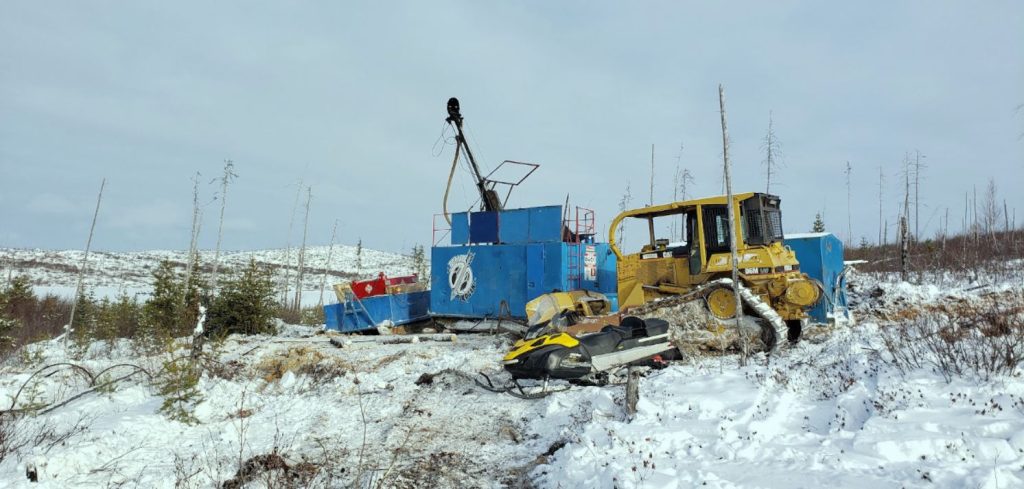Power Nickel drills 0.28 g/t gold over 7.75 metres at Nisk, Quebec

Power Nickel Inc. [PNPN-TSXV; PNPNF-OTCQB; IVVI-FSE] reported the discovery of a new high-grade copper/platinum group element mineralized zone approximately 5 km northeast of the main Nisk deposit, northern Quebec. The target area was never previously drilled and was identified as “Wildcat”. It is characterized by a strong magnetic anomaly from an ultramafic unit previously mapped in the surface outcrop. Ultramafic rocks consistent with the main Nisk deposit were intersected in hole PN-23-031A, but the high-grade mineralization is hosted in amphibolite and tonalite, which lie on top of the ultramafic sequence.
Hole PN-23-031A intersected multiple chalcopyrite stringers and veinlets almost continuously in the first 60 metres of the drill hole. The thickness and density of these stringers increased from 60.50 to 68.25 metres down the hole. The main mineralization is characterized by a high density of chalcopyrite veinlets with local massive chalcopyrite. The veins are greatly enriched in platinum and palladium with significant accessory gold and silver. The samples are rich in platinum, and palladium will be re-analyzed to include the complete Platinum Group Elements (PGE), such as osmium, iridium, rhodium, and ruthenium.
Drill hole PN-23-031A returned 1.00 metre of 0.34 g/t gold, 10.0 g/t silver, 1.10% copper, 0.02 g/t palladium and NSR platinum. PN-23-031A returned 7.75 metres of 0.28 g/t gold, 13.1 g/t silver and 1.47% copper, 5.71 g/t palladium and 20.76 g/t platinum, including 1.75 metres of 0.52 g/t gold, 25.0 g/t silver, 3.90% copper, 19.97 g/t palladium and 90.60 g/t platinum.
The Wildcat area represents an entirely new target to explore and is wide open laterally along strike and at depth. This new discovery is very significant with high-grade platinum and palladium associated with copper.
“Wow, what a hole! Hats off to the team for identifying the outcrop and selling me on testing it. We did not go too deep, only 200 metres, as we will be conducting the Ambient Noise Tomography over this area, looking for similar signatures that we have on our main Nisk mineralized zone. It is entirely possible that the massive sulfides containing the nickel sequence are below this unit deeper in the Ultramafic. It’s not unheard of for nickel deposits to have a lot of high-grade PGM’s but this hole is special. Obviously, we will be following this sector up in our next round of drilling. This certainly has the potential to contribute greatly to the project’s economics,” commented Power Nickel CEO Terry Lynch.
“This was a great surprise following up on continued good news from the exploration program. Recently we conducted an Airborne EM survey over our mapped 5.5 Kilometre Ultramafic section, and preliminary data review identified several encouraging signals that will require follow-up exploration and eventually drilling in our fully funded Q3/Q4 2023 campaigns that will commence sometime around late July,” Lynch advised.
The Nisk Project is located in the southern portion of the Eeyo Istchee James Bay territory, Quebec, the site of a number of mining projects improving infrastructure.
Power Nickel completed the acquisition of its option to acquire up to 80% of the Nisk Project from Critical Elements Lithium Corp. [CRE-TSXV]. The Nisk Project comprises a large land position (20 km of strike length) with numerous high-grade Nickel intercepts.
The existing resource estimates at the Nisk project are of historic nature, and the company’s geology team has not completed sufficient work to confirm a NI 43-101 compliant mineral resource. Measured resources are 1,255,000 grading 1.09% nickel, 0.56% copper, 0.07% cobalt, 1.11 g/t palladium and 0.20 g/t platinum. Indicated resources are 783,000 tonnes of 1.00% nickel, 0.53% copper, 0.06% cobalt, 0.91 g/t palladium and 0.29 g/t platinum. Inferred resources stand at 1,053,000 tonnes of 0.81% nickel, 0.32% copper, 0.065 cobalt, 1.06 g/t palladium and 0.50 g/t platinum.
Power Nickel expects to take the results from the historical drilling programs, its initial program in late 2021, the current drill program, and a new metallurgical study and prepare a new 43-101, which we would expect to deliver in Q3 2023.
